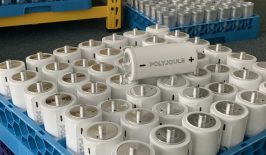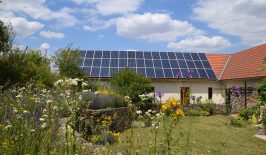Has your smartphone ever overheated? Or has your laptop fan ever sounded as if it were about to take off? What these situations show is that heat is generated wherever large amounts of data are processed. To prevent devices from overheating and suffering damage, they need to be cooled down. This applies not only to small processing devices like smartphones, laptops and the like, but also to data centres. In these huge centres, server after servers span huge areas, working tirelessly to process our data. Every search engine query, every e-mail, every action, no matter how small, that is carried out online travels as a data packet through data centres and their servers — while the heat generated in the process needs to be constantly cooled down. Above all, this results in a huge amount of electricity being consumed.
Energy Hungry Data Centres
It is impossible to say with certainty how much energy is currently consumed by all data centres worldwide. Various calculations range from 200 to 500 billion kWh. That might be hard to imagine, but put it like this — if the internet were a country, it would be somewhere between third and fifth place in the ranking for global energy consumption. Mechanical cooling is responsible for about 25 percent of the total electricity consumption of a data centre. And the residual heat? The vast majority is completely wasted.
In order to reduce the astronomical CO2 emissions of data centres, it is not only a matter of operating them with renewable energies, but energy-efficient cooling, as well as smarter use of waste heat, are essential.
Stockholm Is Heated With Computing Power
In some places, the waste heat from our daily digital use is already being put to use. Sweden is a pioneer in this regard. The three data centres Pionen, Thule and St: Erics, for example, already supply thousands of households in Stockholm with heat. With its cool climate, the Scandinavian country is an ideal location for data centres as less electricity is needed for cooling. Simultaneously, Sweden already has a well-developed heating network, relying mainly on district heating to heat its buildings. This makes using the waste heat from the data centres easier, as it can already be easily fed into the district heating network.
In Germany, there are two examples of a new residential area being supplied with heat from data centres. VW Financial Service’s new data centre in Braunschweig conducts about two percent of its waste heat into the adjacent residential area, and in new residential quarter Westville in Frankfurt, about 70 percent of the heat demand will soon be covered by waste heat from the neighbouring data centre.
Of course, it is also conceivable that the surplus heat is not only fed into local and district heating networks, but also used to supply buildings such as swimming pools, laundries or greenhouses that need heat permanently. The first examples of this already exist. The UK-based company Deep Green, for example, provides free hot water to swimming pools, district heating systems and other industries using the heat generated from their data centres.
Waste Heat Utilisation as a Recycling Process
The processes for utilising waste heat are actually quite simple from a technical point of view. The waste heat can be used directly, or after it has been upgraded. When the heat is used directly, it is transported via a so-called heat exchanger from the data centre via pipes, directly into a greenhouse, for example. In order to transfer the heat into the heating system of a building or room, the waste heat can also first be absorbed by a cooling liquid – such as water or glycol – via a heat exchanger and then transferred via another heat exchanger. If the heat is to be fed into a higher-temperature heat network, then the temperature of the waste heat is upgraded by a heat pump. “On the whole, waste heat utilisation from data centres is a kind of recycling process,” says Mira Weber, who is dedicated to waste heat utilisation from data centres as project manager of Bytes2Heat.
The technologies for waste heat utilisation are therefore already available – and, as the examples mentioned show, are already being used successfully. Nevertheless, very few data centres rely on waste heat recycling.
How Does Waste Heat Utilisation Gain Momentum?
While Sweden might be pioneering this technology, other countries are not quite there yet. In Germany, the heat from data centres has so far remained largely unused. That is partly due to the companies themselves. Since waste heat utilisation is not part of the data centres’ core business, it is not a high priority, says Mira Weber.
Another reason is that infrastructural challenges complicate the recycling of waste heat. Compared to Scandinavian countries, local and district heating networks in some countries, like Germany, are less well-developed, so the heat cannot easily be fed into existing networks. “In addition, the data centres and heat consumers often don’t know that they are in close proximity and would first have to come together,” Weber reports.
But with the rising prices for fossil fuels, interest in sustainable heat is growing and, at the very latest for climate protection reasons, there should also be political interest in utilising the heat sources from data centres.
In one study for Elsevier researchers conclude that about 20 to 60 percent of the total energy input can be reused — a substantial percentage. Deep Green even claims to be able to capture 90 percent of waste heat it produces and the start-up Cloud&Heat from Dresden claims to reuse 90 percent.
“The Borderstep Institute assumes that in Germany alone, the total electricity demand of data centres will increase to 28 billion KWh (2030). In terms of Europe, that would probably be 19.7 to 59 billion KWh for 2030,” estimates Benjamin Ott, a research assistant at the University of Stuttgart who specializes in waste heat utilisation in data centres. “So using waste heat from data centres could theoretically cover up to 2 percent of Germany’s total space heating needs for private households.” This means that a large city like Berlin could, theoretically, be completely supplied with waste heat.
Many direct usage options do not require the use of heat pumps. However, these are still mostly necessary for feeding into the heating network at present, as there are only a few low-temperature networks. According to Ott,
“There is, however, a development that benefits us. New buildings are being equipped with large-scale underfloor heating systems and old buildings are gradually being renovated. This reduces, for one thing, the temperature demand and the heat demand, for which the waste heat from data centres is “perfect” and could supply more households in the future“.
A waste heat utilisation mandate or the compulsory provision of waste heat by data centres and a feed-in priority for climate-neutral heat by heat grids could be an important political framework to recycle the waste heat from our computing power across the board. “This must be complemented by a transparency obligation. Because waste heat utilisation is a joint task. For this, heat networks and heat sources must become transparent and make their temperatures, feed-in points, etc. publicly accessible,” says Mira Weber. This calls above all for uniform regulations throughout the EU.

Mira Weber has been dedicated to waste heat utilisation from data centres as Bytes2Heat project manager since April 2021. Previously, she studied Business Administration at the University of Mannheim and Corporate Management & Economics at Zeppelin University. During her studies, she worked as the CEO of an educational initiative, head of a sustainability institution and as a sustainability consultant.
In order to accelerate the use of waste heat from data centres in Germany and simultaneously bring together relevant stakeholders, the project “Bytes2Heat” was launched, which is funded by the Federal Ministry of Economics and Climate Protection (BMWK). Together with the project partners, the Deutsche Unternehmensinitiative Energieeffizienz e.V. (DENEFF), the Institutes IER and IVR of the University of Stuttgart and the Innovative WärmeNetze GmbH (IWN), the project aims to develop solution tools via a platform that make waste heat from data centres usable in the heating sector. “For example, you can use our matching tool to find the right waste heat utilisation partner or use our profitability calculator to calculate the profitability of a potential waste heat utilisation project,” Weber reports.
Even in countries that need to adapt their infrastructure to these solutions, things are moving.
In Germany, concrete pilot projects are to be developed in the next few years to promote nationwide implementation. It allows us to see a move positive future for the rapidly accelerating increase of server farms worldwide.










